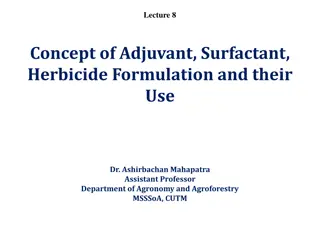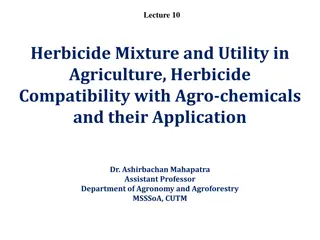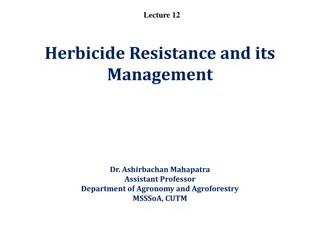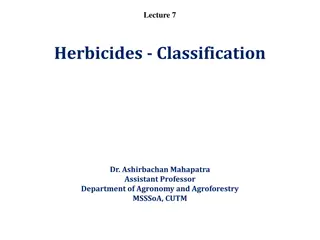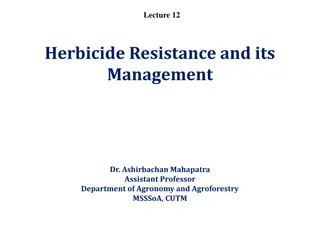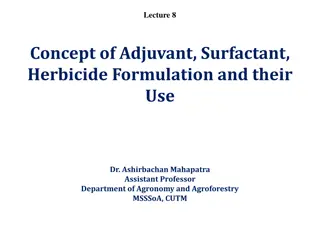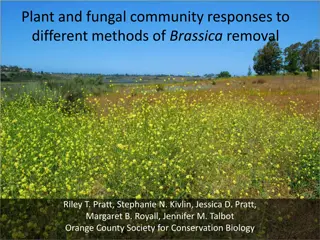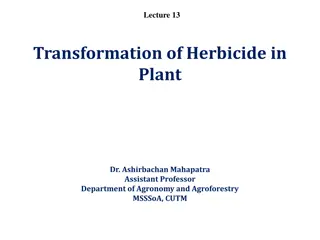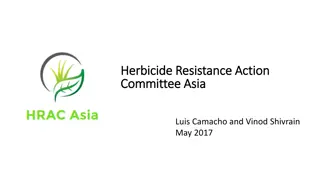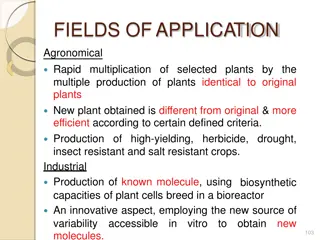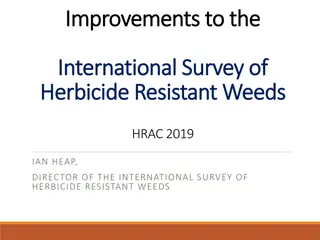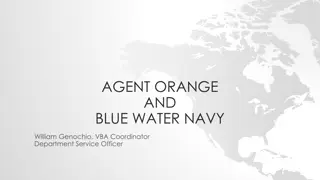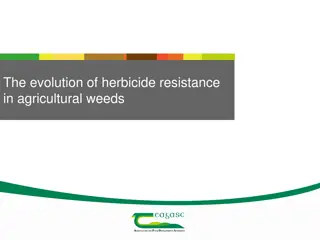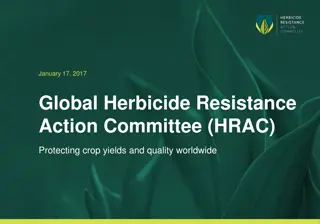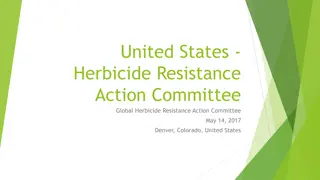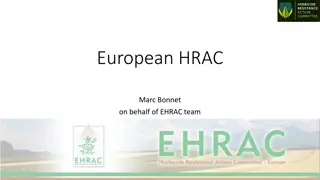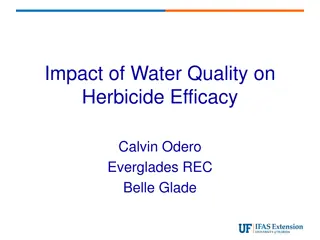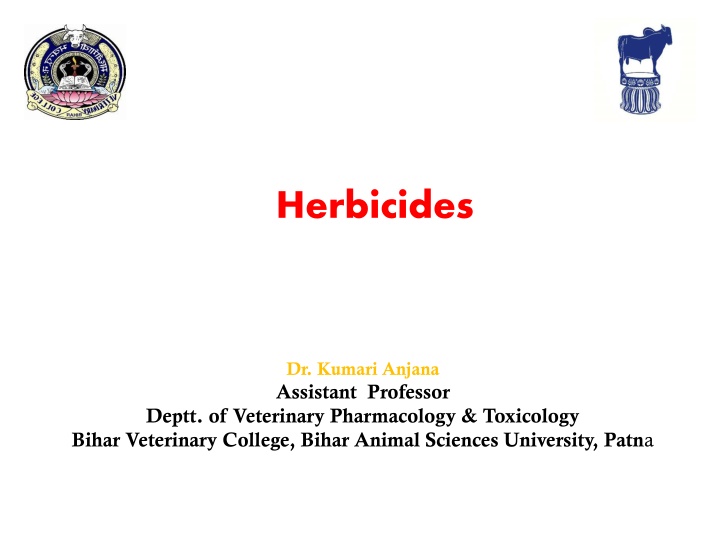
Herbicides: Classification, Clinical Signs, and Treatment in Animals
Learn about herbicides, their classification, mechanism of action, clinical signs of poisoning, diagnosis, and treatment in animals. Understand the importance of proper herbicide use to prevent toxicity issues in animals.
Download Presentation

Please find below an Image/Link to download the presentation.
The content on the website is provided AS IS for your information and personal use only. It may not be sold, licensed, or shared on other websites without obtaining consent from the author. If you encounter any issues during the download, it is possible that the publisher has removed the file from their server.
You are allowed to download the files provided on this website for personal or commercial use, subject to the condition that they are used lawfully. All files are the property of their respective owners.
The content on the website is provided AS IS for your information and personal use only. It may not be sold, licensed, or shared on other websites without obtaining consent from the author.
E N D
Presentation Transcript
Herbicides Dr. Kumari Anjana Assistant Professor Deptt. of Veterinary Pharmacology & Toxicology Bihar Veterinary College, Bihar Animal Sciences University, Patna
Content of the chapter Introduction Classification Mechanism of action Clinical signs Diagnosis Treatment
Herbicide Introduction Herbicides are used routinely to control noxious plants. Most of these chemicals, particularly the more recently developed synthetic organic herbicides, are quite selective for specific plants and have low toxicity for mammals; other less selective compounds (e.g. dinitrophenols) are more toxic to animals. arsenicals, chlorates,
Most toxicity problems in animals result from exposure to excessive herbicides because of improper or careless use or disposal of containers: When used properly, problems are rare. quantities of Vegetation treated with herbicides at proper rates normally will not be hazardous to animals, including humans. Particularly after the herbicides have dried on the vegetation, only small amounts can be dislodged.
When herbicide applications have been excessive, damage to lawns, crops, or other foliage is often evident. The residue potential for most of these agents is low. However, the possibility of residues should be explored if significant exposure of food-producing animals occurs. Herbicide poisoning is a rare finding in veterinary practice. With few exceptions, it is only when animals gain direct access to the product that acute poisoning occurs. Acute signs usually will not lead to a diagnosis, although acute GI signs are frequent.
Classification of Herbicides 2 major groups: Inorganic Herbicides Arsenicals- Sodium arsenite Chlorates- Sodium chlorates Organic Herbicides
Organic Herbicides On the basis of chemical nature: Dinitro compound- dinitro ortho cresol (DNOC), dinitrophenol Phenoxyacetic acids - 2,4-D, 2,4,5-T etc. Bipyridium compounds- diquat, paraquat etc. Heterocyclic compounds or triazenes- atrazine, propazine, simizine. Chloroaliphatic acids - dalapon, sodium chloroacetate, sodium trichoroacetate etc. Substituted urea - monouron, diuron, isoproturon etc. Substituted dinitroaniline - pendimethalin.
Mechanism of Toxicosis: Not known. phosphorylation synthesis. These and uncouple depress oxidative ribonuclease Cause cytotoxicity to visceral and reproductive organs. Interfere transmission. Increase HCN and nitrate content and palatability of such plants. with neuromuscular Signs and Symptoms: Anorexia, diarrhoea, muscle weakness, incoordiantion and metabolic acidosis.
Sources Accidental ingestion of herbicide spills. Improper disposal of herbicide spills. Grazing in recently herbicide-sprayed fields. Malicious poisoning.
Chlorophenoxy Compounds (Phenoxyacetic acid compounds) The most important and most frequently used herbicides. It can potentiate the toxic effects of some plants . Increases the nitrate content of certain plants and increases the palatability of certain toxic plants, thus increases the poisoning risk. Dogs are most sensitive animals.
Paraquat is a very reactive compound. It is actively taken up by the alveolar cells via a diamine where it readily accepts an electron from NADPH to become reduced paraquat. When the reduced paraquat is reoxidized by loss of electron, a superoxide anion radical O2- is generated. The spontaneously breaks down to the reactive singlet oxygen. The reactive singlet polyunsaturated lipids membranes to form lipid hydroperoxides. superoxide radical is unstable and oxygen associated attacks with the cell
These converted to non toxic lipid alcohols by the selenium containing enzyme glutathione peroxidase. lipid hydroperoxides are normally Selenium deficiency, depletion of glutathione or excess lipid hydroperoxides allow the lipid hydroperoxides to form lipid free radicals. The action of paraquat in lungs is similar to that produced by carbon tetrachloride in liver.
Small amount of superoxide that are produced normally in tissues are also scavenged by superoxide dismutase, an enzyme that converts superoxide to H2O2 The H2O2 is detoxified by catalase or glutathione peroxidases. If the detoxification of H2O2 does not happen fast enough, the H2O2 may form highly reactive hydroxyl radical. Lungs tissue is deficient in super oxide dismutase, so it is more susceptible to the excess superoxides generated by paraquqte.
Signs and Symptoms Anorexia, abdominal pain, vomiting, pulmonary oedema, dyspnoea, jaundice, tachycardia, corneal opacity, ulceration of mm, skin, cyanosis.
Dinitrophenol Derivatives The dinitro phenol derivatives possess: insecticidal, fungicidal, acaricidal herbicidal actions. It highly toxic to mammals.
Machanism of Toxicosis: These uncouple oxidative phosphorylation. In ruminants the dinitro derivatives are converted to nitrates, which in turn to nitrites, which after absorption cause methaemoglobinemia. Deplete liver glycogen. Signs and Symptoms: Hyperthermia, convulsions, coma and death. Yellow skin, conjunctiva or hair. Corneal opacity (cataract). dyspnoea, acidosis, tachycardia,
Sodium Chlorate: Rarely used. Causes hemolysis and methaemoglobin formation. Chlorobenzoic acid derivatives: 2,3,6 Trichlorobenzoic acid (2,3,6-TBA). Mechanism of Toxicosis: Not known. Signs and symptoms: Like Chlorophenoxy compounds.
Treatment No specific antidotes. Symptomatic and supportive treatment.

